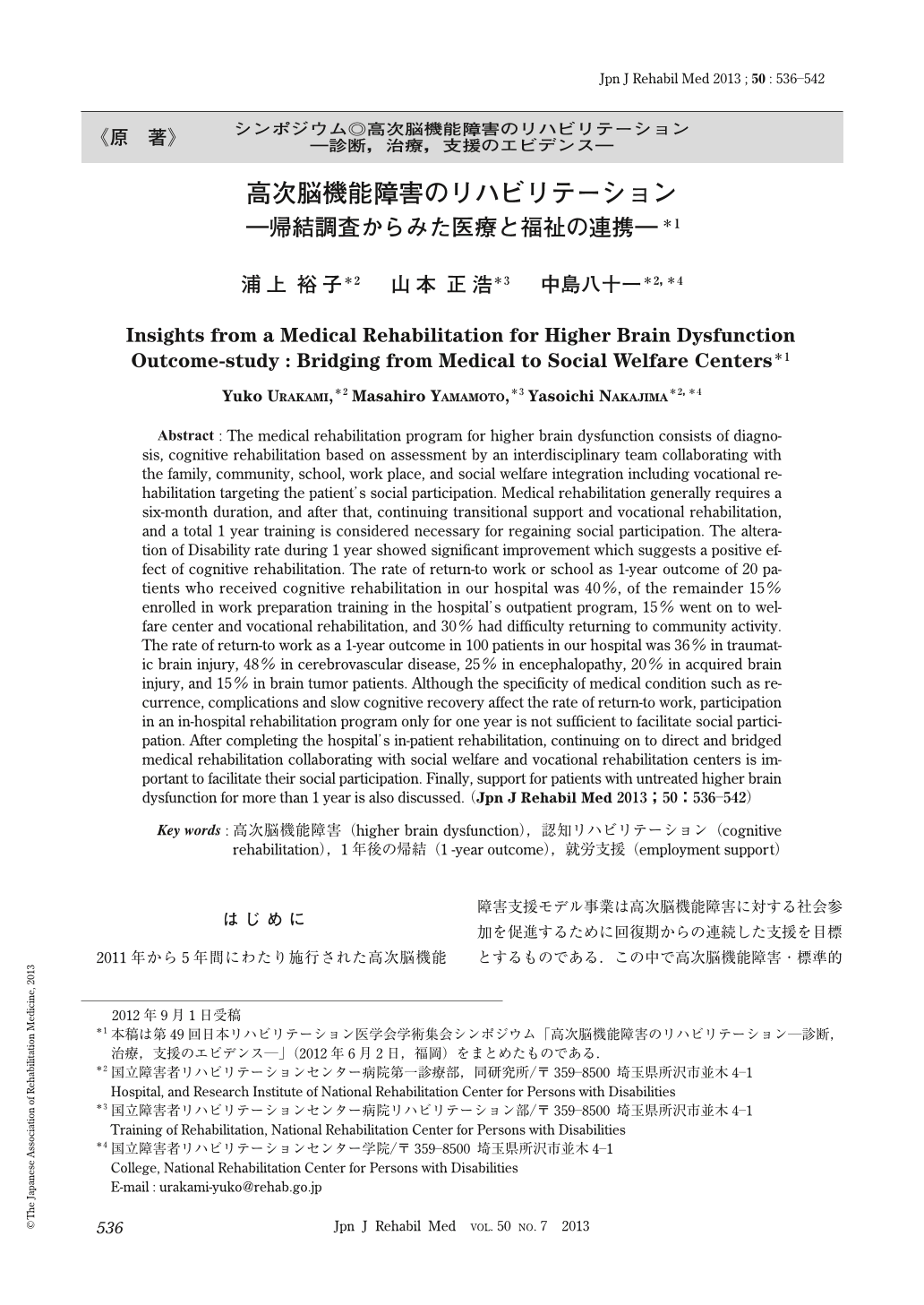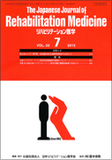Japanese
English
- 販売していません
- Abstract 文献概要
- 1ページ目 Look Inside
- 参考文献 Reference
はじめに
2011年から5年間にわたり施行された高次脳機能障害支援モデル事業は高次脳機能障害に対する社会参加を促進するために回復期からの連続した支援を目標とするものである.この中で高次脳機能障害・標準的訓練プログラムは,発症・受傷からの相対的な期間と目標によって3つの訓練(医学的リハビリテーション(以下,リハ)プログラム,生活訓練プログラム,職能訓練プログラム)が定義された.訓練を受けた障害者で障害尺度(Modified from Health Index by Rosser RM, 1988)(表1)の改善がみられたケースの74%が6カ月で,97%はその1年で成果が得られていることから,機能回復を中心とする医学的リハプログラムは開始から最大6カ月実施,その後は必要に応じて生活訓練・職能訓練を加えて連続した訓練を実施し,全体で1年間の訓練が望ましいものとされた1).
医学的リハプログラムとは,まず医師が診断基準に基づいて高次脳機能障害を正確に診断し,合併症を医学的に管理しながら,症状・個人的因子・社会的背景から統合的に判断して目標を設定,リハ計画をたてるものである.次に多専門職種によるインターディシプリナリーチームにより,高次脳機能障害に対して,日々・週間・月の目標をたて,定期的なカンファレンスの中で,活動状況を評価,必要に応じて目標を修正する.家族の心理的教育を行ない,地域社会・福祉機関・生活訓練・職能訓練と連携して,それぞれの立場から社会参加を目標とするものである2)(図1).
本稿では,はじめに医学的リハプログラムとして認知リハを行った患者の発症または受傷1年後の状態像を明らかにするために,国立障害者リハビリテーションセンター病院(以下,当院)で医学的リハプログラムを受けた高次脳機能障害者20名の1年後の帰結・社会参加の状況を報告する.
次に当院の患者100名を対象に,高次脳機能障害を生じる疾患別の1年後の帰結を検討する.
一方で,すべての高次脳機能障害者が標準的リハを受けているわけではない.発症・受傷から1年以上未診断で経過し,社会適応に問題をきたしてはじめて医療機関を受診する場合がある.この段階で適切に診断,介入する必要が生じる.そこで当院を受診した30例の特徴・介入・帰結調査から慢性期における医学的リハ介入の意義について考察する.
これらの結果から社会参加を促進するために必要な医療と福祉の連携について考察する.
Abstract : The medical rehabilitation program for higher brain dysfunction consists of diagnosis, cognitive rehabilitation based on assessment by an interdisciplinary team collaborating with the family, community, school, work place, and social welfare integration including vocational rehabilitation targeting the patient's social participation. Medical rehabilitation generally requires a six-month duration, and after that, continuing transitional support and vocational rehabilitation, and a total 1 year training is considered necessary for regaining social participation. The alteration of Disability rate during 1 year showed significant improvement which suggests a positive effect of cognitive rehabilitation. The rate of return-to work or school as 1-year outcome of 20 patients who received cognitive rehabilitation in our hospital was 40%, of the remainder 15% enrolled in work preparation training in the hospital's outpatient program, 15% went on to welfare center and vocational rehabilitation, and 30% had difficulty returning to community activity. The rate of return-to work as a 1-year outcome in 100 patients in our hospital was 36% in traumatic brain injury, 48% in cerebrovascular disease, 25% in encephalopathy, 20% in acquired brain injury, and 15% in brain tumor patients. Although the specificity of medical condition such as recurrence, complications and slow cognitive recovery affect the rate of return-to work, participation in an in-hospital rehabilitation program only for one year is not sufficient to facilitate social participation. After completing the hospital's in-patient rehabilitation, continuing on to direct and bridged medical rehabilitation collaborating with social welfare and vocational rehabilitation centers is important to facilitate their social participation. Finally, support for patients with untreated higher brain dysfunction for more than 1 year is also discussed.

Copyright © 2013, The Japanese Association of Rehabilitation Medicine. All rights reserved.


